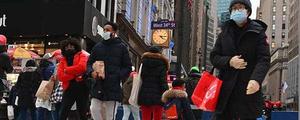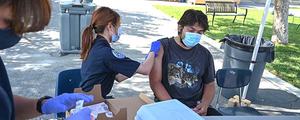Story Highlights
- Adults under age 65 twice as likely as seniors to be unable to pay
- Medication insecurity highest for those most in need of prescriptions
- 10% have skipped prescribed dosages to preserve drugs and save money
Editor's Note: The research below was conducted in partnership between West Health and Gallup.
WASHINGTON, D.C. -- Seven percent of U.S. adults -- representing an estimated 18 million persons -- reported in June that they were unable to pay for at least one doctor-prescribed medication for their household during the prior three months, according to the most recent West Health and Gallup survey. This percentage is in line with the 6% reported in March. Among those in households earning less than $24,000 per year, however, the percentage has jumped from 10% to 19%, a statistically significant increase.
| Mar 2021 | Jun 2021 | Mar-Jun change | |
|---|---|---|---|
| % | % | (pct. pts.) | |
| U.S. adults | 6 | 7 | +1 |
| Annual household income | |||
| Less than $24,000 | 10 | 19 | +9* |
| $24,000-<$48,000 | 10 | 12 | +2 |
| $48,000-<$90,000 | 6 | 7 | +1 |
| $90,000-<$180,000 | 2 | 4 | +2 |
| $180,000+ | 2 | 2 | 0 |
| Age | |||
| 18-49 | 7 | 8 | +1 |
| 50-64 | 6 | 8 | +2 |
| 65+ | 3 | 4 | +1 |
| West Health-Gallup Healthcare Study, March 15-21, 2021 and June 14-20, 2021; * = significant (p<.05) | |||
| Gallup Panel | |||
While affordability of prescription drugs is an issue for all age groups, the inability to pay for a prescription runs twice as high for households with an adult younger than 65, compared with households that have at least one senior (8% to 4%, respectively). This is despite the fact that prescription drug usage climbs significantly with age. Among seniors, for example, 40% report currently having at least five prescription drugs, compared with 23% among those aged 50-64 and less than 10% among those younger than 50.
These surveys were conducted by web from June 14-20, March 15-21 and Jan. 25-31, 2021, with adults aged 18 and older, living in all 50 U.S. states and the District of Columbia via the Gallup Panel, a probability-based, non-opt-in panel of about 120,000 adults nationwide.
Medication Insecurity Climbs With Chronic Conditions and Prescriptions
Being unable to afford medication over the prior three months climbs with medical need. Among respondents with three or more chronic conditions, or eight or more prescriptions, reports of being unable to pay for a prescribed drug in the household reach 11% and 18%, respectively. Among respondents with no chronic conditions and no more than two prescribed drugs, these household rates drop to 4% and 5%, respectively.
| Yes | |
|---|---|
| % | |
| Number of chronic conditions | |
| 0 | 4 |
| 1-2 | 6 |
| 3+ | 11 |
| Number of prescription drugs | |
| 0-2 | 5 |
| 3-4 | 7 |
| 5-7 | 11 |
| 8+ | 18 |
| West Health-Gallup Healthcare Study, June 14-20, 2021 | |
| Gallup Panel | |
Respondents with certain chronic conditions are significantly more likely to suffer medication insecurity than are adults generally. These include those who have been diagnosed with diabetes (12%), chronic obstructive pulmonary disease or COPD (12%), depression (12%), and those who are immune compromised (15%).
One in 10 Skip Pills to Save Medicine, Money
While 7% of Americans report that they have or a family member has gone without at least one prescribed medication because of costs, 10% report skipping dosages in the prior 12 months as a way of saving medicine and, therefore, money. This rate is considerably higher among lower-income households. Among respondents in households earning less than $48,000 annually, for example, 18% report that they or someone in their household had skipped a pill. Even among higher-income households earning $90,000-$180,000, 7% of respondents report having skipped a pill in the prior 12 months.
Adults younger than 65 are also about twice as likely as seniors to report skipped doses in their households as a way to preserve medicine and save money, a pattern similar to what this research found with the inability to pay for prescriptions in the prior three months.
| Yes, skipped a pill | |
|---|---|
| % | |
| U.S. total | 10 |
| Annual household income | |
| Less than $48,000 | 18 |
| $48,000-<$90,000 | 9 |
| $90,000-<$180,000 | 7 |
| $180,000+ | 2 |
| Age | |
| 18-49 | 11 |
| 50-64 | 11 |
| 65+ | 6 |
| West Health-Gallup Healthcare Study, Jan. 25-31, 2021 (n=4,098) | |
| Gallup Panel | |
Implications
The latest results from the West Health-Gallup research into U.S. healthcare add to a growing body of data indicating how Americans cope with the high cost of care. Chief among the prior insights are that an estimated 18% of adults, or about 46 million people, could not afford needed care if they required it today and, separately, that 16% of workers remain in unwanted jobs so they can keep the health benefits the job provides them.
Beyond care itself, the second main aspect of healthcare costs in the U.S. is the price consumers pay for prescription drugs. Before President Joe Biden's inauguration, lowering drug costs was the second-highest healthcare priority Americans had for him, after reducing health insurance premiums. Two-thirds of U.S. adults said reducing drug costs was a "high" or the "highest" priority, including 62% of Republicans.
The roughly 7% of Americans who have been unable to pay for prescribed drugs in the prior three months and the 10% who are skipping doses to save medication because of costs further expose this issue in stark terms. These practical manifestations of how Americans manage their healthcare costs underscore the urgency of the issue, particularly for those younger than 65, nearly all of whom do not yet qualify for Medicare.
The disproportionate manner in which prescription drug prices are affecting sicker and lower-income Americans is also apparent. This reveals an unfortunate scenario whereby those who are most in need of prescription drugs are also the most likely to ration their use if they are able to afford them at all. Substantial majorities of U.S. adults, in turn, support government involvement in a number of aspects of cost control, including setting limits on drug price increases and allowing government negotiation of prices for high-cost drugs for which there are no competitors.
Learn more about how the Gallup Panel works.




